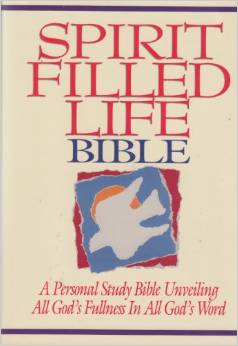Spirit Filled Life Bible, reviewed by Dony Donev
Study Bible Series
There has been a growing number of Study Bibles released in the last few years and Dony Donev is reviewing them along with some classic Study Bibles. Dr. Donev will be evaluating each of the Bibles by focusing on subjects such as the gifts and ministry of the Holy Spirit, free will and the security of the believer, as well as prophecy and eschatology.
 Jack Hayford, ed., Spirit Filled Life Bible: A Personal Study Bible Unveiling All God’s Fullness in All God’s Word (Thomas Nelson, 1991).
Jack Hayford, ed., Spirit Filled Life Bible: A Personal Study Bible Unveiling All God’s Fullness in All God’s Word (Thomas Nelson, 1991).
The Spirit Filled Life Bible is another great example of a Pentecostal study Bible from the 90s, which sets the stage for this century’s Study Bible revival. It was edited by Jack Hayford who later served as president and chancellor of King’s University (formerly The King’s College and Seminary). The text provides Bible commentary from a conservative Pentecostal perspective and study notes are a bit more detailed than the Fire Bible.
For example, the first Old Testament control passage we use in our study from Numbers 6 is well documented and discussed almost verse by verse. Under the title of “Priestly Blessing,” the Spirit Filled Life Bible makes the case for: (1) wave offering as part of worship (v.20), (2) personal blessing through the singular “you” in the original Hebrew (v.22), (3) a definition of blessing (v. 24) and much more on the final phrases in the blessing: “make His face shine upon you” and “lift up His countenance upon you.”
Jeremiah 18 also has several historical commentaries in the Spirit Filled Life Bible as part of Jeremiah’s laments described in a note in chapter 11. The point here is being made that the responsibility for the law in the Old Testament was given to the priest.

Latest redesign of this popular Study Bible: New Spirit-Filled Life Bible: Kingdom Equipping Through the Power of the Word
The doctrine of the Rapture is commented in Revelation 4 in both the footnotes and a special block note within the text. The first one gives three views of the Last Days (dispensational, futurist and historic/preterist), while the second correlates with the elements of John’s vision. The dispensational interpretation is offered in continuity with the interpretation of the 7 Churches of Asia-Minor. Two other block notes with markings “Word Wealth” and “Kingdom Dynamics” are placed in 1 Thess. 5 explaining the origin of the word “Rapture.” Pentecostals will find it significant that the phrase “in the Spirit” is explained as “a state of heightened spiritual sensitivity.”
The Tribulation is also clearly explained as post-Rapture event with a classic interpretation of the prophecy given in the text of Daniel 8. The 24 elders are viewed as “evidence of the church’s exemption from the Great Tribulation” as they “are already glorified, enthroned and crowned,” which without a doubt proceeds from pre-Millennial doctrinal interpretation.
The doctrine of the Trinity is preserved as per the Biblical Truths of the Foursquare Church, namely: “Trinity of God the Father, God the Son and God the Holy Spirit.” The word “Trinity” itself is absent from the detailed word Concordance at the end of the Spirit Filled Life Bible. And although it is not present in the actual Biblical text, it is persistently present in the commentaries. This is true even in the largely disputed (from a manuscript point of view) 1 John 5:5-6 which is explained as trinitarian in the comments.
Category: Biblical Studies, Spring 2014


